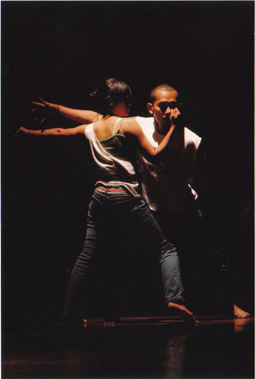 |
The Young |
To get to this final point of undemanding honesty, the dancers in Muslimin Bagus Pranowo's duet have to scrabble through a thicket of teenage angst. In a scene as bleak and empty as a nightclub after closing time, the two battle for the many pairs of sneakers littering the dim stage. The girl, performed by Maharani, wears the drainpipe jeans so favoured by the young. Hard eyed and hard mouthed, she gives as good as she gets. Being the first to wear one sneaker on her foot puts her in command. Wearing two sneakers, she assumes a tough-guy nonchalance, folding her arms and leaning on the boy as if on a sidewalk lamp-post, he bending in acquiescence.
The fast, aggressive movement, accompanied by a choppy and harsh electronic score, full of loud squawks and scratches, did not allow much leeway for subtle emotional expression. Nevertheless, the boy, performed by Muslimin, comes off as the more indecisive and piteous character, undermined by sexual frustration. Early in the work, he reaches through the girl's legs from behind and grabs her crotch, a gesture of aggressive lechery that she completely ignores. Later he fends the girl off and goes for a shoe, only to suffer sudden performance anxiety. When the girl lies on her back, sneakered feet in the air, he performs a short solo of agony; it is deliberately unclear whether he lusts after the girl or the shoes. When he finally does claim his own pair of sneakers, they fail to make him happy; rather than acquiring a sense of confident adulthood (feigned or not) as the girl did, he continues with the jumping, rolling, charging movement as if nothing has changed.
The sneakers are objects of fetishization, whose overt use—to protect feet—is overshadowed by their symbolic value: the possession of coveted material goods, the construction of an individual identity, maturity or sexual attractiveness. When they first encountered the shoes, both boy and girl were similarly perplexed. They seemed not to know what they were for, wearing them on their hands and pressing them to different parts of their bodies. What should be a display of bad breeding (proximity between shoes and heads in Asian cultures being extremely rude) is rendered instead as a moment of quiet intimacy. With the shoes to separate them, the pair touch each other as they otherwise cannot. Simultaneously, the thumping score descends into radio static, displacing the scene from the pressure of normal life. Suddenly realising what they are doing, the dancers freeze, then break away.
The movement vocabulary of The Young is appropriately transnational, almost unplaceable, but more similar to Western contemporary than any Indonesian cultural dance. Only one moment locates the movement within a distinctly Indonesian idiom. The two dancers crouch, proffering a sneaker with both arms fully extended towards the audience, their heads ducked down between their shoulders. In this stance one might present an offering to a king, especially if one had done something very wrong and was appealing for forgiveness. Oh, figure of authority, the dancers seem to plead, take away these shoes, this source of rancour and unhappiness that tortures us! But it is only a moment quickly washed away in an unrelenting wave of movement.
At 25 years of age, Muslimin already shows an easy ability to manipulate a variety of cultural movement vocabularies. The video projection element in The Young, however, was too diffuse and brief to have much impact, but the performers were confident and skillful, and the work explores a tightly coherent theme with insight and maturity. As part of IDF 2010's opening night, The Young is a strong representation from its namesake cohort as well as an illustration of the festival theme "Powering the Future."
The Young, choreographer Muslimin B Pranowo, dancers Muslimin B Pranowo, Maharani, musi Edwin-Gusur Prasetyo, lighting, artistic arrangement Joko Jazz Sriyona; Graha Bhakti Budaya, Taman Ismail Marzuki, Jakarta, June 14
Bilqis Hijjas creates, performs, produces, teaches and writes about contemporary dance in Kuala Lumpur, Malaysia. She also runs a residency for choreographers at the private arts centre Rimbun Dahan and is strongly involved with the Malaysian dance association, MyDance Alliance.
© Bilquis Hijjas; for permission to reproduce apply to [email protected]








 back
back